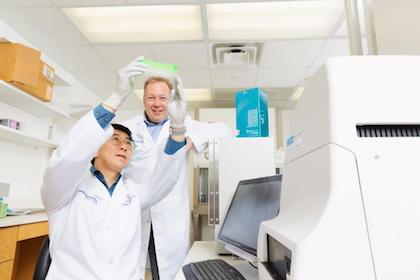Protein associated with Alzheimer's also causes dysfunction in fat cells, increasing obesity, diabetes risk

DALLAS – Dec. 10, 2019 – A protein linked to Alzheimer’s disease in the brain also causes problems in the body’s fat cells, where it invades the cells’ energy centers, increasing obesity and the risk of diabetes, according to a study published online today in Nature Metabolism.
Amyloid precursor protein (APP) – which some consider the evil player in the neurodegeneration of Alzheimer’s disease – shows up at far higher levels in fat cells in mice and humans who are obese, said the study’s senior author, Dr. Philipp Scherer, Director of UT Southwestern’s Touchstone Center for Diabetes Research and Professor of Internal Medicine and Cell Biology.
Perhaps overwhelmed, the fat cell’s internal delivery system malfunctions and incorrectly sends APP molecules to the mitochondria – energy-producing subcellular compartments – rather than to a pathway for transport to the surface of the cell, Dr. Scherer said.
But APP molecules are too large to pass through the mitochondria’s tiny entry pores, Dr. Scherer said. “They get stuck and cannot go forward or backward. When a large enough number of import sites are blocked, the entire import machinery is disrupted and the mitochondria can no longer function properly.”
The result is increasing dysfunction, with the fat cells swelling as they retain lipids and become less able to respond to insulin or metabolize glucose, said Dr. Scherer, who holds the Gifford O. Touchstone, Jr. and Randolph G. Touchstone Distinguished Chair in Diabetes Research. “The mitochondria cannot keep up with the demand for energy inside the cells, which leads to insulin resistance, a precursor to diabetes. The more a human fat cell has of the APP, the worse off the whole system is.”
Researchers had known that obese individuals express higher levels of APP – but they did not know the effect of this accumulation within the cells, Dr. Scherer said. This study shows that the result is clogged mitochondria, leading to obesity and insulin insensitivity.
“APP causes fat tissue to become dysfunctional,” said Dr. Yu A. An, a UT Southwestern postdoctoral researcher and first author of the study. “We also uncovered the reason fat cells do not handle high levels of APP well – the protein is mistargeted to the wrong location within the cell. We traced this mistargeting to a component of the cell’s signal recognition particle, which normally directs APP to the secretory pathway.”
In the study, researchers tested mice designed to develop high levels of APP, as well as mice in which APP could be largely eliminated. Mice with high APP levels got much fatter on the same amount of food, had trouble metabolizing glucose, and their insulin resistance increased. When APP was removed, the mice were less likely to become obese, glucose intolerant, or insulin resistant.
To determine whether the same effects happen in humans, the researchers worked with Dr. Samuel Klein from the Washington University School of Medicine, a physician who provided fat tissue biopsies from obese patients. The researchers found that levels of APP correlated with obesity and insulin resistance.
The researchers will now look for ways to reduce levels of APP or the signal recognition particle’s problem component (SRP54c) that is tied to the incorrect delivery of APP in fat cells. They will also try to better understand why APP increases so much with obesity and why the protein causes fat cells to retain lipids, thereby growing larger.
The problematic APP in the brain is found in nerve cells. Given these new insights on the protein’s negative effects on fat cells, it may prove possible to develop novel strategies to understand how APP acts on nerve cells in the brain, Dr. Scherer said. “Our observations may help to explain some of the cellular misfortunes that occur in the process of Alzheimer’s as well,” he said.
Researchers from the University of Gothenburg, University of Texas Health Science Center at Houston, and Shanghai Jiao Tong University School of Medicine also participated.
The study was funded by grants from the National Institutes of Health, Novo Nordisk Foundation, Pershing Square Foundation, and Swedish Research Council.
About UT Southwestern Medical Center
UT Southwestern, one of the premier academic medical centers in the nation, integrates pioneering biomedical research with exceptional clinical care and education. The institution’s faculty has received six Nobel Prizes, and includes 22 members of the National Academy of Sciences, 17 members of the National Academy of Medicine, and 15 Howard Hughes Medical Institute Investigators. The full-time faculty of more than 2,500 is responsible for groundbreaking medical advances and is committed to translating science-driven research quickly to new clinical treatments. UT Southwestern physicians provide care in about 80 specialties to more than 105,000 hospitalized patients, nearly 370,000 emergency room cases, and oversee approximately 3 million outpatient visits a year.
